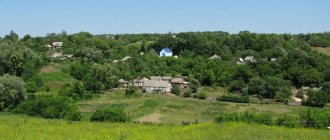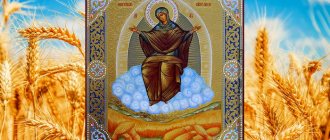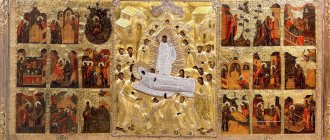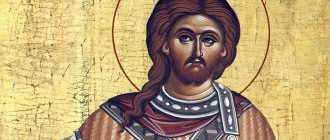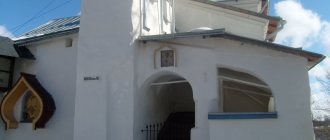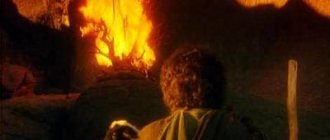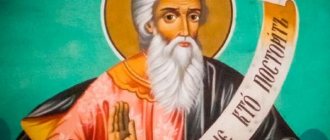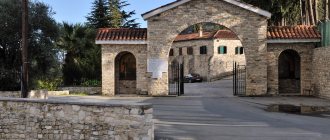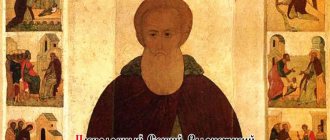The miraculous image of the Mother of God “Hodegetria” Shuiskaya is remembered three times a year:
- August 10 is the day of honoring all the Mother of God icons “Hodegetria”;
- November 15 - a holiday established in memory of the writing of the Shui icon and the end of the plague epidemic in Shui in 1655;
- Tuesday of Holy (Easter) Week - on this day the first miraculous healing occurred after prayer in front of the icon.
The history of the Shuya miraculous image “Hodegetria”
According to legend, the icon was painted during a pestilence that struck the Russian lands in 1654–1655. The inhabitants of Shuya trusted only in God's help and fervently prayed to the Lord and the Most Holy Theotokos.
One of the pious parishioners suggested ordering a new image of the Mother of God for the Church of the Resurrection. Believers happily responded to the request and raised money to paint the image. The icon was commissioned to be painted by master Gerasim Ikonnikov. The famous Smolensk icon (“Hodegetria”) was taken as a model.
Miraculous events occurred already during the work of the icon painter. The outline images that Ikonnikov made turned out to be corrected: the position of the legs of the Infant Jesus differed from the canonical ones adopted when painting the image of Hodegetria.
At first, the painter tried to continue working according to the rules approved by the Church. But after two corrections, I did not dare to contradict the will of God. Ikonnikov preserved the changes that became a characteristic feature of the Shuya miraculous icon.
Work on the image lasted a week, after which the icon was reverently brought into the Church of the Resurrection and placed in the iconostasis to the left of the Royal Doors. According to eyewitnesses, a wonderful light and fragrance emanated from the image, and believers found hope of deliverance from the plague.
After some time, the epidemic actually stopped, and the sufferers were healed. But the disease did not spare the icon painter Ikonnikov and his family. They died of the plague, but before their death they managed to take monastic vows and prepare for the transition to another world.
For several years, through prayers at the Shuya icon, miraculous healings occurred: believers were delivered from deafness, blindness, demonic possession and paralysis. In 1666, clergy from Moscow arrived in the city. They studied evidence of miracles and healings associated with the icon, and established a day of all-Russian veneration of the shrine (November 15).
In 1831 and 1848, after a religious procession with the Shuya miraculous icon “Hodegetria,” the cholera epidemic in the city stopped. The miraculous healings of believers continued after a prayerful appeal to the Mother of God before the miraculous image.
Until 1939, the Resurrection Church in Shuya operated and services continued there. Until this time, the miraculous shrine remained in its place. After the closure of the Church of the Resurrection, the icon was considered lost. Only later lists made from the original image have survived.
The history of the establishment of the feast of the Smolensk and Shuya Icons of the Mother of God
July 28/August 10 is the day of celebration of the Shuya-Smolensk Icon of the Mother of God.
This memorable date is associated with the day of all-Russian glorification of the main city shrine in 1667. The appearance of the said icon in Shuya in 1654 was significant not only for the Shuya fortress, but also for the entire Russian state. The holiday, celebrated by the Russian Church on August 10 (July 28, Art.), pays honor to two icons of Hodegetria, Smolensk and Shuisk. Initially, this day of remembrance was related only to the icon of Hodegetria of Smolensk and is associated with the Presentation[1] of her Moscow copy, placed in the Mother of God of Smolensk Cathedral of the Novodevichy Monastery (since 1525). The icon of Hodegetria itself, brought to Rus' from Constantinople in 1046, was located in Smolensk and therefore was named after the city. In the middle of the 15th century, Hodegetria of Smolensk was in Moscow for some time, and the Novodevichy Convent was built on the site of the Muscovites' farewell to the great shrine, before its return to Smolensk.
Moscow list of Hodegetria of Smolensk, 1456 GMMK
The holiday on July 28 was established at the beginning of the 16th century, separately for the Moscow principality and was distinguished by special veneration among the people. Later, in 1667, on the day of the Presentation of the Icon of Hodegetria of Smolensk, a holiday was dedicated to Hodegetria of Shuiskaya. The combination of the celebration of two icons of Hodegetria, different in iconography, was reflected in business documents of the 17th century[2], where the icon from Shuya was called the “newly painted Hodegetria of Smolensk”.
The new image of the Mother of God was painted in Shuya during the pestilence of 1654/55, which engulfed the central region of the Moscow state. The situation was complicated by the fact that the epidemic coincided with the siege of Smolensk, captured by the Poles, by the tsarist army. The plague approached Shuya from Moscow, bypassing quarantine barriers. In 42 days (from September 1 to October 12), 560 inhabitants (according to other sources, 574 people) died from the pestilence in the fortress and settlement, i.e. about half of Shuya's population at that time. At the beginning of October, at the height of the epidemic, according to the vow of the parishioners of the Church of the Resurrection, “what is in the settlement”, the Shuya master Gerasim Ikonnikov created in seven days the icon “The Most Holy Theotokos, Honest and Glorious Her Hodegetria of Smolensk” [3], which soon received the name “Shuya " It was with the appearance of this image of the Mother of God that the Shuyans associated the miracle of stopping the pestilence in the city. Moreover, the fact that the Shuya Icon of the Mother of God differed in iconography from the Smolensk edition was explained in local legend by a miraculous change in the preparatory drawing of the icon applied to the gesso. This appearance of the future image occurred three times, despite the fact that the icon painter tried to return the standard design of the icon of Hodegetria of Smolensk, for which he received an order from the parishioners. This became the first miracle from the Shuya Icon of the Mother of God.
The official glorification of the icon was preceded by the events of 1666, when in a short period of time more than 100 residents of Shuya and surrounding villages received healing from the newly painted icon. It is significant that a special, abundant manifestation of grace from the icon occurred on July 28, 1666, on the day of the celebration of the Hodegetria of Smolensk, and over the two subsequent days (36 healings in total). Considering it their duty to notify the king and the spiritual authorities about these events, the Shuyans compiled a secular petition and dispatched two envoys who delivered it to the capital. Attached to the petition was a record of all the healings, which was later translated into the famous Legend of the Miraculous Icon (1667).
Beginning of the Legend of the Shuya Icon of the Mother of God from the Yaroslavl manuscript of the 17th century. RNB
One of the ancient acts preserved information about the fate of the “painting of miracles”, transferred to the Patriarchal rank. In it, in particular, it says: “And the painting was miraculously presented in Moscow, in the current year of October 175 (1667), on the 21st day, to the Most Reverend Paul [4], Metropolitan of Sarsk and Podonsk, Shui Posad, priest Alexey of Voskresenskaya, and parishioner Afanasy of Voskresenskaya Vasiliev, together with the voivode’s reply, and our worldly petition; and His Grace Metropolitan Pavel sent that military response, and our worldly petition, and miraculously the painting to the patriarchal order”[5]. That is, we see that the news of the miracles performed by the icon was transmitted to the appropriate authority in Moscow on October 21, 1666/67[6]. A quick decision to examine the icon was hindered by the difficult internal political situation associated with the outbreak of a schism and the election of a new patriarch. One of the first acts of the newly elected Patriarch Joasaph II was the glorification of the new icon of Hodegetria from Shuya. There is a well-known blessed letter from Patriarch Joasaph[7] to send a special commission to Shuya, headed by Archbishop Stefan of Suzdal and Tarusa.
Patriarch of Moscow and All Rus' Joasaph II (1667-1672)
This document provided Archbishop Stephen with the necessary authority both to witness miracles and to carry out the necessary canonical acts to glorify the icon. On July 28, 1667, in the Posad Resurrection Church of Shuya, in the presence of the arriving clergy, a festive service and a solemn prayer service took place in front of the new icon. The result of the commission's work was the Book of Testimony, which was presented to Moscow for the court of the Tsar and the Patriarch.
The book of evidence has survived to this day in the original in the manuscript department of the Historical Museum (Moscow). It follows from it that everyone who had previously declared himself healed from the image of the Mother of God was heard by responsible persons in the presence of a confessor, and these words were certified by interviewing other witnesses. The commission took into account not only the applicant’s story about the healing, but also “examined” the state of his health at the time of the certificate, that is, after a year. The inquiry was carried out simultaneously by several groups, each consisting of three persons: a boyar's son, an experienced clerk and a representative of the local clergy. The first in seniority was the group of “spiritual authorities,” headed by Archbishop Stephen. As a result of the work of the commission, four sections of the Book were compiled. The first of them combined healings that were recognized as reliable during the investigation. The second lists episodes that were also quite credible, but caused some disagreement among witnesses. The third section collected cases that were not available for verification. The final part of the Book contained a description of the revered icon and all the values added by admirers of different classes. Also mentioned here is an icon case painted using the rare technique of “gold etching,” which only noble people had the opportunity to order and make. After reading the Book of Testimony of the Tsar and the Patriarch, the icon from Shuya was officially recognized as miraculous and a celebration was established for it on July 28th.
A series of eight ancient acts of 1667 is known, which represents business correspondence that accompanied the glorification of the new icon. This series ends with the blessed letter of Patriarch Joasaph and the report of Archbishop Stephen, mentioned above. These two acts were kept in the library of the Resurrection Cathedral and were a kind of “safe conduct” for the miraculous icon, which became the main shrine of Shuya. Archpriest of the Resurrection Cathedral Evlampy Pravdin, who wrote a brief history of the famous icon, noted the special significance of another act from the mentioned business series (No. 87) and cited its text in his book on the history of the city of Shuya (1884)[8]. It was compiled after envoys from Shuya visited Moscow, but even before Joasaph was elected patriarch, that is, before January 31, 1667. This act, which was considered lost, was recently rediscovered in the collection of the St. Petersburg Institute of History of the Russian Academy of Sciences.
| “The well-known petition of the priests of the Church of the Resurrection of Christ in Shuya on Posad Alexei and Gregory and the townspeople about healings from the icon of Hodegetria of the Smolensk Mother of God located in that church.” Act No. 87 from the collection. V.A. Borisov (St. Petersburg Institute of the Russian Academy of Sciences, No. 448). |
It ends with a petition to the Tsar, “so that the miraculous and holy icon of the Mother of God and Her miracle-working <...> may be known,” that is, it actually asks the Tsar to witness miracles from the new icon.
In the last letter from this correspondence, sent from Shuya shortly after July 28, the Resurrection Church is already referred to as the “Church of the Blessed Virgin Mary.” This remark can be interpreted in the sense that the lower, St. Nicholas throne of the church was consecrated anew, during the glorification of the Hodegetria icon. And 6 years later, in 1673, in Yaroslavl, that is, in the neighboring diocese, the throne was also consecrated “in the name of the Most Holy Theotokos of Shuya” [9], which reflected the beginning of widespread popular veneration of the new Hodegetria from Shuya.
Mortgage memorial plaque (1673) from the Demetrius Church in Yaroslavl.
Yaroslavl icon painters often went on pilgrimage to the famous icon. One of such cases is reported in a letter dated July 27, 1674: “Login Sidorov lay in bed and, as promised, went to pray to Shuya to the Shuya Mother of God”[10]. Judging by the date, he went to Shuya on the day of Her holiday. It was in Yaroslavl, as can be seen from these quotes, that the toponym Shuiskaya was assigned to the new icon of the Mother of God. In Shuya itself the name “Hodegetria of Smolensk” was adopted. The combination of the toponyms Smolenskaya and Shuiskaya in the name of the icon from Shuya occurred in the 18th century, and was finally established in the second half of the 19th century, when the need arose to distinguish between the two July holidays - the 11th and 28th [11].
Unfortunately, in the tragic circumstances of the twentieth century, the original miraculous Shuya-Smolensk Icon of the Mother of God, created by Gerasim Ikonnikov, was lost. But today in the collection of the Museum of Russian Icon in Moscow you can see its program list, created shortly after the glorification of the Shuya Icon (1667). The composition of the list affirms the supremacy of the Wisdom of God in the appearance of the icon of the Mother of God in Shuya, as well as the national significance of this providential event. Princes Boris and Gleb (spiritual patrons of the reigning dynasty) were elected to the cathedral of upcoming saints, and with them the Moscow saints: Peter, Alexy, Jonah and Philip, which reflects the symphony of two branches of power, secular and spiritual, as one of the components of the ideology of the Russian kingdom in the 17th century century. Let us add that the features of the face of the Mother of God on this list allow us to speak of the master’s desire to convey as much as possible the features of the authentic icon from Shuya. In other words, the icon from MRI is one of the closest in design to the original from Shuya.
Our Lady of Shuiskaya with saints in the fields. End of the 17th century. Size 70.0 x 59.7 cm. MRI, Moscow
Due to historical circumstances, the memorable date of July 28 is the main celebration of the Shuya Icon. The arrival of the patriarchal commission in Shuya and the recognition of the miracles revealed by the Mother of God from Her Shuya image as true, made it possible to immediately carry out the canonical glorification of this icon, directly in the Resurrection Church of Shuya. The all-Russian glory of the Shuya Lady began from these events, which brought many pilgrims to her, even from the upper classes of Russian society. The day of glorification of the icon was widely celebrated in the Shuya diocese in 2022, in connection with the 350th anniversary of this event.
B.L. Makaryants
Prayer service on the day of the 350th anniversary of the Shuya Icon of the Mother of God. August 10, 2017.
[1] According to the Saints from the handwritten Trebnik of the 16th century, the day of memory of Hodegetria, July 28, is called the day of “The Meeting of the Most Holy Theotokos of Smolensk.” State Historical Museum, Uvarov collection, No. 79, L. 340. According to legend, an exact copy of the Hodegetria icon was brought to Rus' from Constantinople in 1046 and placed in Smolensk.
[2] Borisov V.A. Description of the city of Shuya and its environs. M., 1851. Acts on the miraculous icon of the Shuya Mother of God. pp. 422–438.
[3] Ibid., Acts No. 87, 92, 93. P. 424, 434, 437. The full name of the icon is mentioned three times in the business series of 1667. This “full title” is called by both the patriarch, the bishop, and the Shuya clergy.
[4] Metropolitan Pavel of Sarsk and Podonsk, at the time of the transfer of the petition and the painting of miracles, was the locum tenens of the Patriarchal Throne and was in charge of the affairs of the “Patriarchal Rank” (Razryadny Prikaz).
[5] Ibid., Act No. 86. P. 423.
[6] The text of the letter states the year 1667 according to the September New Year, but in the translation into the January style - the transfer of the original “painting” and the petition refers to the previous year, 1666.
[7] At the end of the original letter there is an exact date: “written in Moscow in the summer of July 7175 {= 1667} on the 21st day.” Ibid., Act No. 92. P. 435.
[8] Pravdin Evlampiy, archpriest. Description of Shuya and Shuya churches. Shuya, 1884.
[9] This name of the throne was preserved in the 1673 inscription on the foundation board of the Demetrius Church. See illus. 6.
[10] Kochetkov I.A. Dictionary of Russian icon painters of the XII–XVII centuries. 2009. Quote based on RGADA documents. F 396., op. 1. No. 15019. L. 1-4.
[11] Calendar convergence with the Rzhev Icon of the Mother of God, also celebrated on July 11/24, gave a second toponym, and the holiday on this day was colloquially called the “Shuya Rzhev” Icon of the Mother of God. But the trace of the celebration on July 11/24 goes back to the history of Yaroslavl veneration of the Shuya Hodegetria.
What do they pray for in front of the Shuya Icon “Hodegetria”
The main thing that believers ask for before the miraculous Shuya icon is deliverance from dangerous diseases and protection from pestilence. For several centuries, the Mother of God granted Her intercession to all who resorted to her help. Healing occurred even in the most hopeless cases.
People turn to the Shuya Icon when:
- family troubles and conflicts;
- difficulties in raising children;
- despondency and melancholy;
- weakening of faith.
The Mother of God always helps sincere believers and those who trust in her intercession.
| Icon of the Mother of God “SHUISKAYA” HODEGETRIA August 10 (July 28, old style), November 15 (2) and Tuesday of Bright Week
Description of the icon of the Mother of God “SHUISKAYA”: An excerpt of the Icon of the Mother of God “HODEGETRIA” of Shuya was written by a pious monk of the Resurrection Church in the city of Shuya during the raging pestilence of 1654–1655. After painting the image, through prayers to the Most Holy Theotokos, the pestilence began to weaken, and then stopped altogether. The celebration of the icon of the Mother of God of Shuya takes place three times: on August 10 - together with other Hodegetria icons, on November 15 - in memory of the painting of the icon and the beginning of the end of the pestilence, on Tuesday of Bright Week - in memory of the first recorded miracle that occurred from the icon. An iconographic feature of the Shuya Icon of the Mother of God, which distinguishes it from other icons of the Hodegetria type, is the characteristic position of the right leg of the Infant God, the heel of which He supports with his hand. In 1922, the miraculous Shuya Icon of the Most Holy Theotokos was removed from the church, and since then there has been no information about its whereabouts. ________________________________________________ Troparion to the Most Holy Theotokos in front of Her icon, called “Shuiskaya-Smolenskaya” Troparion, tone 4 As a valuable treasure, the city of Shuya has received your wonderfully painted icon, Most Holy Lady, Virgin Mother of God, for the healing of severe ulcers and for the consolation of the Orthodox, given by You, from which springs of grace flow abundantly to this day. Increase, O Most Pure One, and for the future we will show Your mercy to You, protect Your city and the entire Russian land and save the people who flow to You with faith and love. |
____________________________________________
Also read on our website:
The earthly life of the Mother of God - Description of the life, Nativity, Dormition of the Mother of God.
Apparitions of the Mother of God - About the miraculous apparitions of the Mother of God.
Icons of the Mother of God - Information about the types of icon painting, descriptions of most icons of the Mother of God.
Prayers to the Mother of God - Basic prayers.
Lives of the Saints - Section dedicated to the Lives of Orthodox Saints.
For the beginning Christian - Information for those who have recently come to the Orthodox Church. Instructions in spiritual life, basic information about the temple, etc.
Orthodox parables - Collection of small parables (stories)
Literature - Collection of some Orthodox literature.
Orthodoxy and the occult - Orthodoxy's view of fortune-telling, extrasensory perception, the evil eye, corruption, yoga and similar “spiritual” practices.
Superstitions - Description of some superstitions.
__________________________________________________
__
Orthodox online distance learning course (free)
We recommend taking this course to all beginning Orthodox Christians. Online training takes place twice a year, sign up for the next courses today!
The first Orthodox radio in the FM range!
You can listen in the car, at the dacha, wherever you do not have access to Orthodox literature or other materials.
_________________________________
https://ofld.ru - The Ray of Childhood Charitable Foundation is kind and generous people who have united together to help children who find themselves in difficult life situations! The fund supports children from 125 social institutions in 8 regions of Russia, including babies from 16 orphanages. And these are orphans from the Chelyabinsk, Sverdlovsk, Kurgan, Orenburg and Samara regions, as well as children of the Perm Territory, the Republic of Bashkortostan and the Udmurt Republic. The main task remains to provide everything necessary for children from children's homes, where our smallest charges are located - children aged from 1 month to 4 years.
Prayer to the Most Holy Theotokos in front of Her Hodegetria icon Shuiskaya
“Oh, Holy Virgin! I pray, look at me, hear my prayers and help me overcome misfortunes. Heal children from diseases and illnesses. Free those suffering from serious illnesses from torment and pain. Drive away everything bad and evil from my life. Become my intercessor, be near me and do not leave me in difficult moments. Give me a happy, kind and bright life. Don't let darkness envelop my soul. My hope and delight are only in you. May I praise Your Most Holy name. May I honor You, O Great Mother of God! In the name of the Father, and the Son, and the Holy Spirit! Amen".
Sun, 14 Nov 2022 14:38:10 +0300
Golaeva Irina
In the footsteps of a lost shrine: Smolensk Icon of the Mother of God
Kontakion 1. Chosen from all generations, heaven and earth, to the Queen, the Most Holy Theotokos Hodegetria, as having been delivered from eternal death by grace from You, the birth of Christ our God and Your Mother Before Him, by intercession, we offer songs of thanksgiving to You, Thy servants. You, our All-Merciful Intercessor, free us from all troubles and sorrowful circumstances and guide us to the kingdom on high, so we call You: Rejoice, Mother of God Hodegetria, Christian hope knowledge.
Ikos 1. The Archangel's voice cries out to Ti, the Pure One: Rejoice, O Blessed Hodegetria Mary, and fill us with spiritual joy, so that we may bring Ti with a reverent soul and a pure heart, who gave birth to the world the Savior Christ our God, these words are: Rejoice, you who have been blessed with favor by God the Father; Rejoice, unartful Mother of God the Son. Rejoice, holy abode of God the Holy Spirit; Rejoice, manifestation of the Trinity mysteries. Rejoice, wonder of angelic minds; Rejoice, ornament of the human race. Rejoice, thou who art united above with those below; Rejoice, you who opened the gates of paradise to earthly creatures. Rejoice, heavenly ladder; Rejoice, ever-accepting God. Rejoice, burning bush; Rejoice, most holy table. Rejoice, Mother of God Hodegetria, hope of Christians.
Kontakion 2. Having seen the icon of Your Most Holy Face, O Virgin Mother of God, the all-praised Evangelist Luke wrote, advertising about it with Your most pure lips: “With this icon is My grace and with ila." Having received such Your promise, we reverently venerate Your most holy image, O Lady, and sing to Your Son and God: Alleluia.
Ikos 2. Having understood Your good will, O Theotokos, for this icon of Yours, the glorious Apostle Luke bestowed it for the blessing and sanctification of the Church of Christ of Antioch, in which she is a Guide Be named and glorified by divine miracles. For this, thanking You, the All-Good Lady, for You have left the likeness of Your most pure face for our consolation, we earnestly cry out to You: Rejoice, Queen of the high and low; Rejoice, Lady of angels and men. Rejoice, peace of peace; Rejoice, destruction of ancient enmity. Rejoice, pillar of virginity; Rejoice, depth of humility. Rejoice, thou clothed in the sun; Rejoice, shining with Divine glory. Rejoice, Mother of the Everlasting Light; Rejoice, heavenly sweet paradise. Rejoice, fragrant heliport of Christ; Rejoice, bed of the Great King. Rejoice, Mother of God Hodegetria, hope of Christians.
Kontakion 3. By the power of God, wonderful miracles were performed from Your icon, the Lady of God, when it was brought to Constantinople and placed in the glorious Blachernae Temple; You enlighten the blind, heal every ailment in people by Your grace, Mother of God, and let us all call to the God who glorified You: Alleluia.
Ikos 3. Constantinople had You as the sovereign Intercessor, the Virgin Mother of God, and in the days of attacks on it by strong and battle-skilled enemies, Your help was many-wonderful from Your holy icon Odiga Three are better. Moreover, we pray to You, O All-Blessed One, just as You saved this ancient city many times from destruction, so save us humble ones from eternal destruction by Your maternal intercession to Christ. gu, let us gratefully call Ty: Rejoice, Tsargrad is a strong fence; Rejoice, blessed treasure of the Blachernae Temple. Rejoice, victory over the wicked armies; Rejoice, shame on the enemies of Orthodoxy. Rejoice, children of Christ, Leader of victories; Rejoice, quick helper in troubles that flow to you. Rejoice, zealous Intercessor of those who call upon you in prayer; Rejoice, God-wise saints, helpers in the gospel of Christ. Rejoice, glory to the women and virgins; Rejoice, pillar of fire, tempering the heat of passions. Rejoice, pillar of the cloud, dispelling the darkness of sins; Rejoice, Mary, Mother of Christ our God. Rejoice, Mother of God Hodegetria, hope of Christians.
Kontakion 4. By the storm of the sea, the ships of the proud Kagan, the city of Thy captivity, which desired, Thou shattered, O Lady, and Thou didst grant victory over it to the people named after Christ from the Holy One and Your Hodegetria horses, emitting rays of heavenly light and enlightening the Orthodox howls with them, so that everyone may know that You are truly the sovereign Voivode of Constantinople and they will glorify Your mercies and miracles, singing to the Savior God: Alleluia.
Ikos 4. Having heard about Your glorious miracles, O Virgin Mother of God, even from Your icon You appeared in Constantinople, we are perplexed as to the icon that is carried throughout the city, by the power of God those who wore them governed and directed their feet according to Your will; guide us, O Lady, and our feet on the path of fulfilling the commandments of Christ, and teach us to faithfully fulfill the holy will of Your Son and God, so that we cry to You: Rejoice, most holy ́ unquenchable; Rejoice, never-setting star. Rejoice, shining with the Divine light; Rejoice, you who enlighten the souls of the faithful with grace. Rejoice, fragrance of the peace of Christ; Rejoice, sanctification of the earth. Rejoice, cup that draws joy to the whole world; Rejoice, source, pouring out eternal sweetness. Rejoice, well-adorned devil of the King of Kings; Rejoice, reddest paradise. Rejoice, brightest morning; Rejoice, all-golden pen. Rejoice, Mother of God Hodegetria, hope of Christians.
Kontakion 5. Like the God-bearing star, Thy icon, Our Lady of God, was brought by Thy favor from Constantinople to the Russian country, and was given to the city of Smolensk as an inheritance of grace, and we also thank Thee , O All-Merciful Lady, for such a holy gift have you given to our Fatherland, and we sing in To the Trinity, glorified God: Alleluia.
Ikos 5. Having seen Your glorious intercession of the city of Smolensk, Most Pure Lady, we glorify Your great mercy, by which You miraculously saved this city from the destruction of Batyev, your eyes With the Divine One who came from Your icon, sent the saint of Christ Mercury to single combat with the leader of the army, Batu; He will strike him with his sword and deliver Your city from the burning of fire. Thou hast crowned him with the crown of martyrdom; with heavenly prayers grant us on earth to cry out to Thee without condemnation: Rejoice, thou who strengthened the martyr of Christ Mercury for his feat of arms. ; Rejoice, you who inspired him with the voice of Your holy icon. Rejoice, for you who crowned David with victory against Goliath; Rejoice, strong defense of the city of Smolensk. Rejoice, thou who delivered Thy city from destruction; Rejoice, Deliverer from captivity and defeat. Rejoice, Russian countries, blessed consolation; Rejoice, God-made decoration of the Church of Christ. Rejoice, everlasting joy to those who love You; Rejoice, Quencher of sorrows. Rejoice, healing of the sick; Rejoice, encouragement to those who are discouraged in sorrow. Rejoice, Mother of God Hodegetria, hope of Christians.
Kontakion 6. The Russian country preaches Thy mercy and miracles, O Most Pure Virgin Mother of God, and the city of Smolensk shines brightly, having Thy miraculous icon, healing all kinds of diseases and healing Giving health to loved ones. For this reason, we reverently venerate Your multi-healing image, O Lady All-Good, and worshiping it, as a guarantee of Your favor towards us, we cry out to God: Alleluia.
Ikos 6. Thou shone in the land of Russia with the rays of Divine miracles emanating from Thy holy icon, O Most Pure Lady, to whom our fathers have come in sorrow and illness since ancient times it is useless to depart. And so we come to You and with love and reverence kissing Your miraculous image, we pray to You: quench our sorrows, heal our ailments, and let us call to You: Rejoice, O about old age; Rejoice, intercession of widows. Rejoice, charity for orphans; Rejoice, education of babies. Rejoice, supply for the poor; Rejoice, liberation of the captives. Rejoice, consolation to those who mourn; Rejoice, pillar and affirmation of virginity. Rejoice, Patroness of monks; Rejoice, nun Teacher. Rejoice, strengthening of the fasting people; Rejoice, help in the feat of virginity for those who strive. Rejoice, Mother of God Hodegetria, hope of Christians.
Kontakion 7. Although you granted the city of Moscow the communion of grace from Your holy icon, O All-Merciful Lady, You deigned to bring Your icon from Smolensk to Moscow, and there remained miracles will be famous by many. When, at the request of the inhabitants of Smolensk, Your holy image returned to their city, at the place where Your icon passed by the Hodegetria, an abode of virgins was quickly built in Your name; In this time, under the shadow of Your miraculous icon, with faith and love we sing a silent song to God: Alleluia.
Ikos 7. The newly created monastery of nuns in the city of Moscow reverently honors the holy likeness of the miraculous icon of Your Hodegetria, indescribable mercy exuding to the faithful, even in the overshadowing You graciously console Orthodox people and affirm them in the feats of fasting and prayer, urging them to ceaselessly chant the Mother of Your generosity and cry out to You with gratitude: Rejoice , beloved by God to the Queen; Rejoice, thou who loved God above all the Lady. Rejoice, one blessed among women; Rejoice, heavenly joy. Rejoice, earthly intercession; Rejoice, shame on demons. Rejoice, hell has been trampled underfoot; Rejoice, strengthened by the power of the Lord of hosts. Rejoice, invested with the power of the Queen of heaven and earth; Rejoice, good Helper of those who wage war on the flesh through chastity. Rejoice, O merciful Comforter of those who strive in fasting and silence; Rejoice, thou who deliverest all sorrows. Rejoice, Mother of God Hodegetria, hope of Christians.
Kontakion 8. The earthly journey of many sorrows and many rebellions, you delight us with your maternal care for us, Mother of God, and in days of sorrowful circumstances you show us holy help for salvation. We remember and confess, O Lady, Your intercession, when the Gauls devastated the Russian country and captured the city of Moscow, You brought Your holy Hodegetria icon from Smolensk to the Poltsi of the Russian army What You deigned to bring and thereby You inspired the Orthodox, You granted them a glorious victory through Your intercession to the Son To yours and to God. To him we sing: Alleluia.
Ikos 8. Filled with all mercy and generosity, O All-Blessed Mother of God, you have most gloriously bestowed help and victory over your enemies on the Orthodox army. And when we no longer had any hope of salvation, as our city was captured and destroyed, you drove the Gauls with dishonor from our Fatherland and crowned us with a wondrous victory. Always remembering your intercession, we cry out in praise to you: Rejoice, you who wonderfully delivered our Russian country from the invasion of foreigners; Rejoice, having brought back the proud with shame in Your power. Rejoice, O All-Powerful Victorious of the armies of other faiths; Rejoice, sovereign supporter of the Orthodox army. Rejoice, thou who art mercifully abiding with Thy holy icon with the Russian soldiers; Rejoice, you who sanctify their armies with Your miraculous image. Rejoice, strengthening those who are weak with power from above; Rejoice, Thou who bestow Thy holy help upon the helpless. Rejoice, O righteous Intercessor of the offended; Rejoice, unreliable hope. Rejoice, joy of the sad. Rejoice, Mother of God Hodegetria, hope of Christians.
Kontakion 9. All the faithful see Your holy image with joy and consolation, and look with tenderness at the Infant Christ, for this reason we pray to You, O All-Good One, as the Mother of all holding in the right hand of His Master: look upon us with mercy, and beg the Lord to have mercy unworthy of us. Teach us, Lady, to pray to Him favorably, and to sing to Him without judgment with undefiled lips and a pure heart the angelic song: Alleluia.
Ikos 9. Our hymn of song does not suffice to glorify your many miracles, O Mother of God Hodegetria, which you showed from your holy icon and always appear to the faithful: both of you, as you are truly the Good Mother, accept our faith and zeal; Weight and love for You are ours, from which our hearts are on fire, and mercifully hear this praise composed in simplicity: Rejoice, O ever-rejoicing Virgin; Rejoice, Unbridled Bride. Rejoice, village of God the Word; Rejoice, monastery of the Most Holy of Holies. Rejoice, forever reigning with the Son, the King of heaven; Rejoice, having greater boldness towards Him. Rejoice, you who mercifully listen to the prayers of the faithful; Rejoice, repaying those who love You with Your Divine love. Rejoice, high adornment of Zion; Rejoice, protection of the world for a long time. Rejoice, city of our salvation; Rejoice, holy city, glorified by the descent of God. Rejoice, Mother of God Hodegetria, hope of Christians.
Kontakion 10. Save us, O Lady, from eternal destruction by Your maternal intercession to Christ God, and grant us to see You at the hour of our death, from the hand of the fierce ruler of the world. keeping ours; May we, through Your holy help, escape its snares and be worthy to receive the Kingdom of Heaven and sing in eternal joy to the Lover of Mankind: Alleluia.
Ikos 10. You are a wall to the virgins, to the Virgin Mary, and to all zealous zealots of virginity and purity. We pray to You, Most Pure One, cleanse our hearts from all sinful filth, and adorn our souls with chastity and purity, so that we may remain unharmed from all the temptations of the world, the flesh and the devil that are found, and we will be honored to worthily proclaim to You the following song: Rejoice, good Nurse of the Virgins; Rejoice, compassionate Trustee of orphans. Rejoice, quiet refuge for those overwhelmed by passions; Rejoice, safe haven for those troubled by temptations. Rejoice, Rewarder of the ascetics of chastity; Rejoice, Helper of those fighting invisible enemies. Rejoice, merciful Visitor of the innocently convicted; Rejoice, good Comforter of those falsely slandered. Rejoice, Divine Liberator of those in captivity and exile; Rejoice, all-powerful Protectress of the toiling and burdened. Rejoice, Judge of the Righteous One; Rejoice, reconciliation of sinners with God. Rejoice, Mother of God Hodegetria, hope of Christians.
Kontakion 11. Hearing the all-compassionate singing from Your faithful servants, ascended by You, Most Pure Mother of the Virgin, who has ineffable mercy, satisfy us with the incorruptible food of the Word of God and teach us to always fulfill the life-giving commandments of our Lord; We implore Him, our All-Blessed Representative, to bestow His mercy on us unworthy and make us worthy to inherit His all-bright and all-blessed Kingdom, where all the saints sing His praises Fucking song: Alleluia.
Ikos 11. With the bright rays of Your miracles, Virgin Mary, you enlighten us with grace, and from Your holy icon of Hodegetria you send spiritual consolation to the saint of God. But to us, sinners, dost thou abundantly give healing gifts from her, and let us call upon thee with gratitude and praise: Rejoice, thou who gave birth to the Lamb and the Imperishable Shepherd; Rejoice, you who combined virginity and Christmas in Yourself. Rejoice, thou tree of virginity, leading to a pure and virginal life; Rejoice, thou who manifestest Thy holy love to God’s chosen one. Rejoice, you who reveals the commands of heaven as a saint to the Lord; Rejoice, thou who hast honored St. Sergius of Radonezh with Your visit. Rejoice, you who directed St. Cyril of Beloezero with a voice from Your icon to Beloezero; Rejoice, you who strengthened the Venerable Savvaty of Solovetsky in his desert exploits. Rejoice, you who blessed St. Mitrophan of Voronezh with Your icon. Rejoice, covering and supply of the abodes of Christ; Rejoice, secret admonition of the servants of God in the midst of the world. Rejoice, Mother of God Hodegetria, hope of Christians.
Kontakion 12. The grace of God acts in miracles, gloriously revealed from Your holy image, Blessed Virgin Mary, enlighten our souls, dispelling the darkness of sin with the radiance of So the Sun of the Truth of Christ, so that in the light of His commandments we may live this temporary life pleasing to God in all piety and purity and Let us be worthy to receive eternal bliss and sing to God with the elect: Alleluia.
Ikos 12. Singing Your miracles, Mother of God, we preach Your mercy, glorify Your innumerable bounties and, falling before Your miraculous icon, we pray with faith and love: Be for us the Good Guide to the bright city of Heavenly Jerusalem, so that we may see You from the height of Your Divine glory on who looks upon us mercifully and, together with the saints, let us sing to Tisa: Rejoice, our most holy joy; Rejoice, our most blessed Queen. Rejoice, Thou who adopted us as sons at the cross of Thy Son and God; Rejoice, you who show motherly love for us. Rejoice, you who wonderfully fulfill our good desires; Rejoice, quick to listen to humble prayers. Rejoice, covering us with Your holy protection; Rejoice, who protects us reliably with Your honest robe. Rejoice, at the hour of our death, our all-powerful Helper; Rejoice, O sovereign intercessor for us in the ordeals of the air. Rejoice, free healing for our bodies; Rejoice, salvation of our souls. Rejoice, Mother of God Hodegetria, hope of Christians.
Kontakion 13. O All-Singing Mother, Queen of the All-Merciful Virgin Mother of God Hodegetria! Accept this little prayer of ours and bring it to Your Son and our God, imploring the Mother of His goodness, may He have mercy on us sinners and unworthy, and for Your sake, the all-powerful intercession of the hut He will make us suffer eternal torment, make us worthy to receive the Kingdom of Heaven, and there the angels will sing to God: Alleluia. This kontakion is read three times, then the 1st ikos and the 1st kontakion.
Ikos 1. The Archangel's voice cries out to Ti, the Pure One: Rejoice, O Blessed Hodegetria Mary, and fill us with spiritual joy, so that we may bring Ti with a reverent soul and a pure heart, who gave birth to the world the Savior Christ our God, these words are: Rejoice, you who have been blessed with favor by God the Father; Rejoice, unartful Mother of God the Son. Rejoice, holy abode of God the Holy Spirit; Rejoice, manifestation of the Trinity mysteries. Rejoice, wonder of angelic minds; Rejoice, ornament of the human race. Rejoice, thou who art united above with those below; Rejoice, you who opened the gates of paradise to earthly creatures. Rejoice, heavenly ladder; Rejoice, ever-accepting God. Rejoice, burning bush; Rejoice, most holy table. Rejoice, Mother of God Hodegetria, hope of Christians.
Kontakion 1. Chosen from all generations, heaven and earth, to the Queen, the Most Holy Theotokos Hodegetria, as having been delivered from eternal death by grace from You, the birth of Christ our God and Your Mother Before Him, by intercession, we offer songs of thanksgiving to You, Thy servants. You, our All-Merciful Intercessor, free us from all troubles and sorrowful circumstances and guide us to the kingdom on high, so we call You: Rejoice, Mother of God Hodegetria, Christian hope knowledge.
First prayer. Oh, Most Wonderful and Above All Creatures, Queen Theotokos, Mother of Heavenly King Christ our God, Most Holy Hodegetria Mary! Hear us, sinners and unworthy, who at this hour pray to You with sighs and tears before Your most pure image, falling down and tenderly saying: Deliver us from the pit of passion. oh, good Hodegetria, deliver us from all sorrow and sorrow, protect us from all misfortune and evil slander, and from the unjust slander of the enemy. You can, O our Gracious Mother, save Your people from all evil, and provide and save with every good deed, unless You have other Representatives in troubles and circumstances and warm Intercessors for us. Those who belong to Your Son, Christ our God, are not imams. We begged Him, O Lady, to save us and grant us the Kingdom of Heaven, so that through Your salvation we may glorify You in the future, just as we are the Author of our salvation, and we extol the all-holy and magnificent and The name of the Father and the Son and the Holy Spirit, in the Trinity glorified and worshiped God forever and ever . Amen.
Second prayer.
To whom shall I cry, Lady? To whom shall I turn in my grief, if not to You, Lady Lady Theotokos, Queen of Heaven? Who will accept my cry and my sighing, if not You, O Most Immaculate One, the hope of Christians and a refuge for sinners? Incline, O Most Pure Lady, Your presence to my prayer. Mother of my God, do not despise me, requiring Your help, hear my groaning and inspire the cry of my heart, O Lady Theotokos Queen. And grant me spiritual joy, strengthen me, who is impatient, sad and careless towards Your praise. Understand and teach me how it is fitting for You to pray, and do not depart from me, Mother of my God, for my grumbling and impatience, but be my protection and intercession in my life and bring me to the quiet haven of blessed peace, and count me to your face Thy chosen flock and there deign me to bless and glorify Thee forever. Amen.
